Just 1.5 hours from downtown San Jose, Poas Volcano National Park is an excellent day trip from San Jose and national park to visit for first time Costa Rica visitors. At this national park, visitors can see two volcano craters 2000 meters up in the cloud forest.
Here is our guide to visiting Poas Volcano National Park. Make sure to read carefully how to purchase park tickets.
This post has affiliate links which we may earn a small commission from if you choose to purchase, at no extra cost to you. Any prices listed may not reflect current pricing. It is the readers responsibility to research current pricing. Prices are quoted in USD. More info: Disclosure
Quick Info About Visiting Poas Volcano National Park
- No 4×4 or 4wd required. Do be careful when driving as the road is curvy, narrow and steep.
- Open 7 days a week from 8 AM to 4 PM (last entry at 2 PM).
- Park tickets must be pre-purchased in order to enter. They do not sell tickets at the door.
- Pregnant women, people with high blood pressure and/or heart problems and those who recently underwent surgery are not recommended due to the high altitude and volcanic activity.
- It can get cold and it may rain any time of the year so bring a sweater and a rainjacket.
- Bathrooms are available at the office. There is also a gift shop and small cafeteria.
- It is recommended to stay only 10 minutes at the active crater viewpoint due to the gases.
- If the gas levels are too high at the crater, they will close the viewpoint or even close the entire national park if they detect high gas levels or high volcanic activity. This is unpredictable but it may occur.
- You need around 2 hours at Poas Volcano if you want to walk both trails. For just the main viewpoint, you need just an hour.
Poas Volcano National Park Location
Poas Volcano National Park is about 50 kilometers (31 miles) from San Jose and a 1.5 hour drive.
Itinerary planning tip: If you’re planning on going from San Jose – La Fortuna/Grecia/Sarchi/Bajos del Toro), you can stop by Poas Volcano National Park on the way.
How to Get to Poas Volcano National Park
If you are renting a car in Costa Rica, the drive up to Poas Volcano is quite beautiful.
Make sure to get our Costa Rica rental car discount!
You do not need a 4×4 for Poas Volcano National Park. However, you will need to drive very slowly because the road up the valley is windy, curvy and narrow. Read more tips for driving in Costa Rica here.
GPS: Input Poas Volcano Parking Lot or Parque Nacional Volcan Poas in Waze or Google Maps.
Along the drive, you will have a great view of the valleys valley and pastures and you’ll pass by local stores that sell strawberries and souvenirs. We really enjoy driving there because the views up to the national park are just stunning.
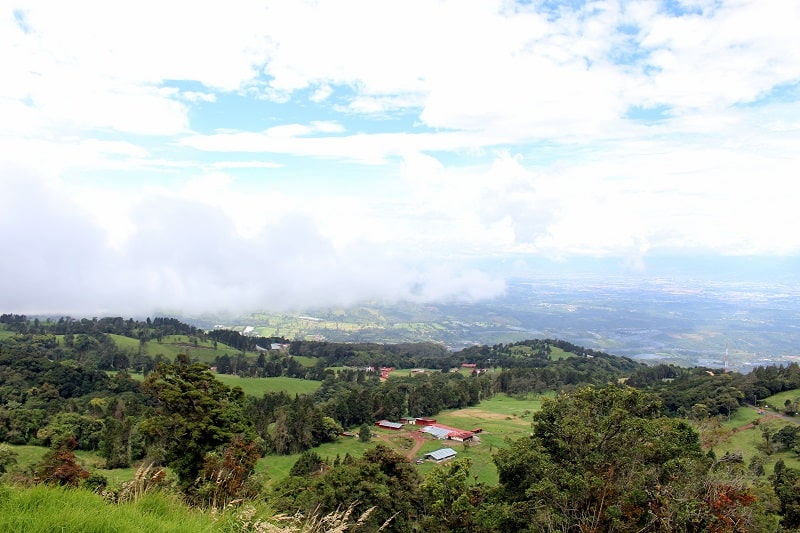
You can stop at one of the souvenir stands along the way to buy some souvenirs and get some snacks. There are also some restaurants with really nice views. We like Típico de Fraijanes and Fresas del Volcan.
Parking
There is a large parking lot at the national park. They will charge you 2000 colones per car and 1000 colones per motorcycle. This parking lot does have surveillance and there is a guard there at all times.
Bus
If you are in San Jose, you must get to Alajuela to take the direct bus to the national park. *Weekends only now.* First, take the TUASA bus that departs from “Iglesia Parque de la Merced” in San José at 8 AM, cost around 1500 CRC round trip. Get off the last stop in Alajuela.
Then, walk 200 meters south to the Prospero Fernandez park near the cemetery and take the COOPETRANSI bus that goes directly to the national park. Saturday and Sundays only at 930 AM.
Return from the national park at 2 PM to Alajuela with Coopetransansi. Costs around 4000 CRC round trip. One way takes around 2.5 hours.
Read more about taking public transportation in Costa Rica here.
Entrance Fee, Park Tickets and Hours
Poas Volcano National Park is open everyday from 8 AM to 4 PM including holidays. The latest entry into the park is 2 PM.
The Poas Volcano National Park entrance fee is $15 USD for foreign adults and $5 USD for children ages 2-12.
Every visitor has to purchase entrance tickets beforehand on the SINAC website to visit the park as they are only allowing a certain number of people in the park a day. They do not sell tickets at the door.
Reservations are set at a certain time but we recommend to arrive around 15 minutes early to check in and park.
How to purchase Poas Volcano National Park tickets
Go to the SINAC website (they have an English option), create an account, register and purchase your tickets there. You can save it on your phone to show to the park ranger or print it out. Tickets are nonrefundable, non changeable and they do not give refunds for no shows.
When you purchase tickets, select “Parque Nacional Volcan Poas” and then select the schedule you want.
What to Know About Visiting Poas Volcano National Park
Poas Volcano National Park was created in 1971 to protect the volcano and surrounding flora and fauna.
In 2017, Poas Volcano erupted several times, spewing rocks so big it damaged the roads and buildings in the park. These eruptions forced the national park to close its door for nearly 1.5 years.
At the end of September 2018, the national park opened its doors to welcome visitors once more.
Poas Volcano National Park Observation Point
Once you’re inside the park, follow the signs to the observation point. This trail is 600 meters (.37 miles) and takes about 10 minutes on a asphalted road.
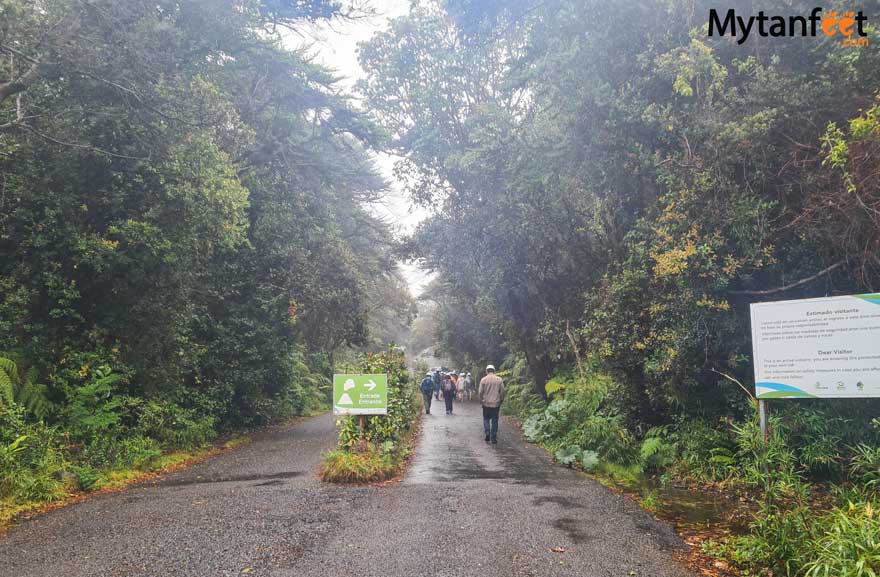
This path is also handicap friendly and is flat. Once you are the view point, you can walk around the platform to see the crater.
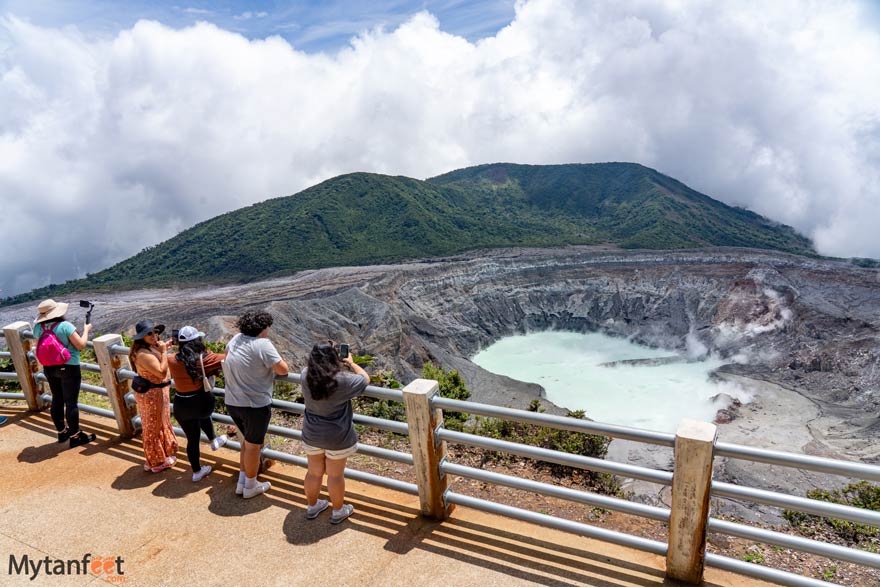
It is not a 100% guaranteed to be able to see the volcano crater clear or completely clear. It depends on weather conditions of the day and since it’s very high in elevation in the cloud forest, it is fickle.
If you arrive and its cloudy, wait. The clouds may clear for just a few minutes to reveal a gorgeous crater lake.
We have visited the park 5 times and have seen the crater clear only twice. Once, we got drenched in a rainstorm in March.
August 2012 (before park closed and volcano erupted)
When we went at the end of August, we were lucky to have a very beautiful and clear day so the crater was clear the whole time we were there.
We went early in the morning, right when the park opened around 830 AM.
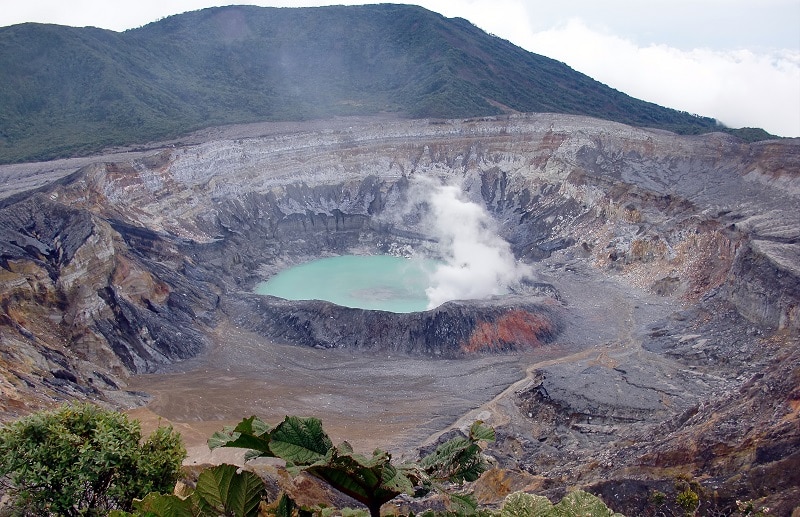
March 2022
We tried again recently but was super unlucky again. Even though March is one of the driest months in Costa Rica, we were having really weird weather these days with lots of wind and cold fronts.
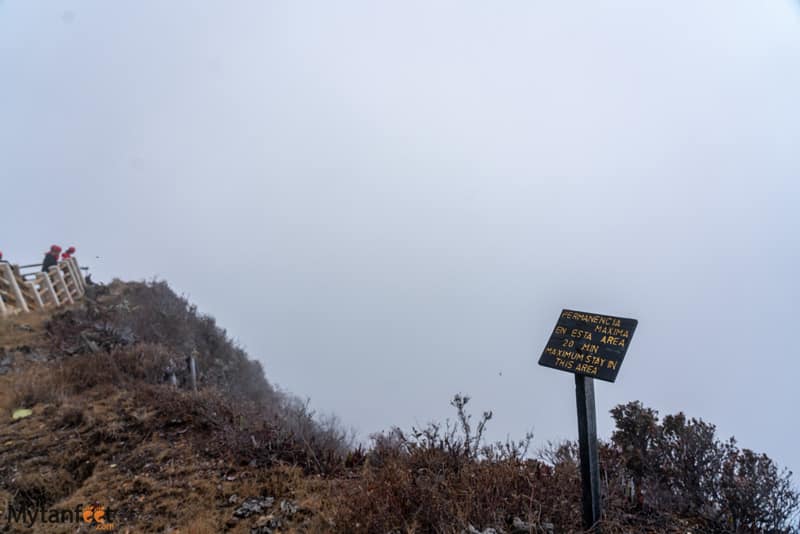
Out of all the times we’ve been to Poas Volcano National Park, this visit had the worst weather. It was raining a lot and it was very windy. The temperature was 57° F (14° C)!
May 2023
Fifth time was the charm and luck was on our side. Even though we visited in May, which is rainy season, this year was an El Niño year so it was much drier than normal. We arrived around 1045 AM and the crater was as clear as could be!
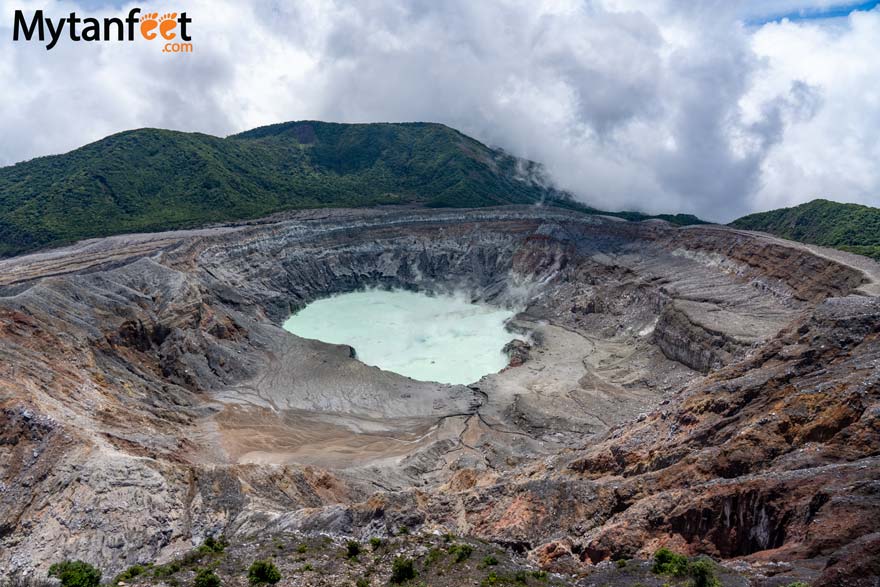
Laguna Botos Trail
The Laguna Botos trail is open to give visitors an additional look at an inactive crater lake. The entire trail is 2.8 kilometers or you can walk to the main lake viewpoint which is 800 meters (.5 miles). The 800 meter trail takes about 20 minutes to get there.
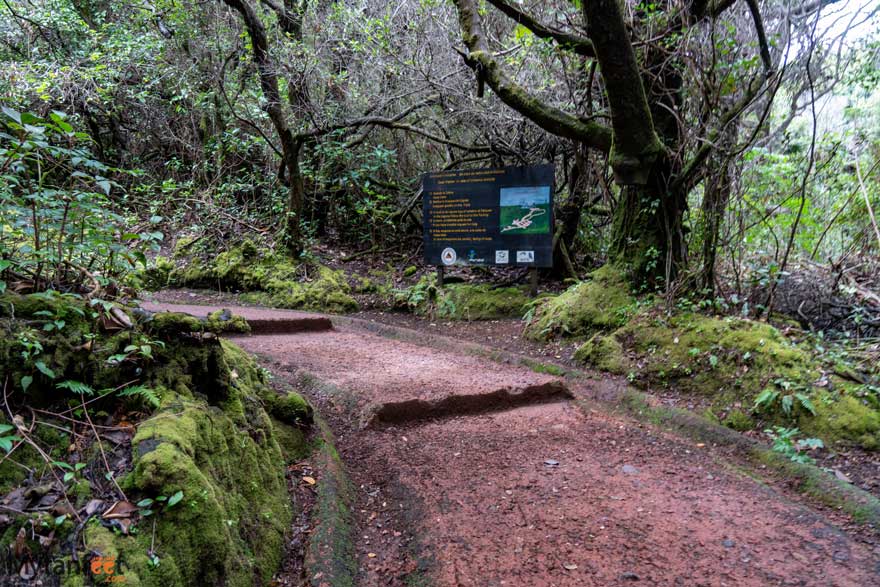
To go back, you walk the same path way so it’s about 40 minutes total walk. If you have time, you can continue onto the other two paths. The hours are 8 AM to 230 PM (cannot enter after 230 PM).
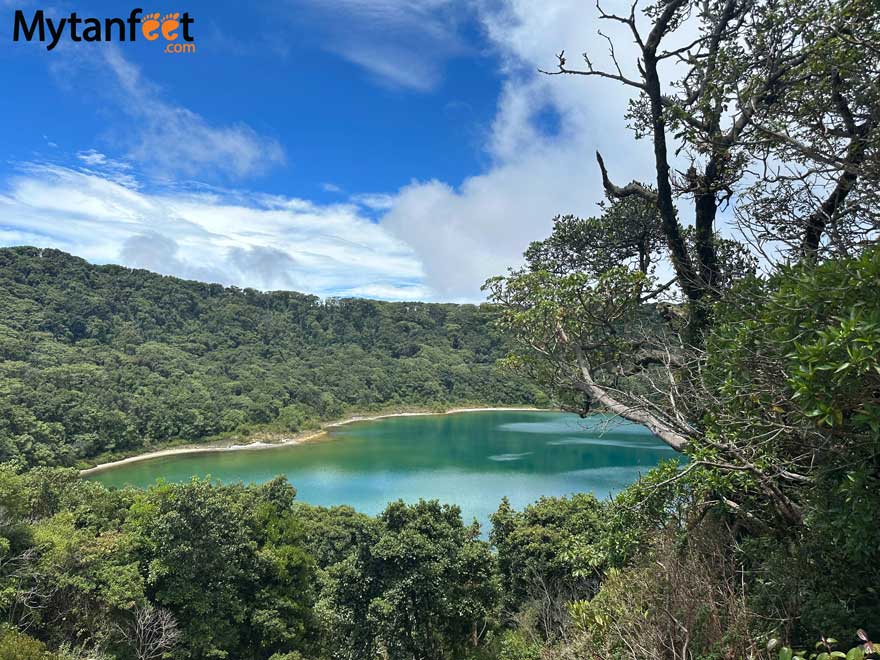
This trail is a medium difficulty. The path is mostly concrete but it does have elevation climb and uneven surfaces, so if you can’t walk long on that kind of paths, we don’t recommend this trail (like if you recently had surgery, knee replacements, ankle problems, mobility problems, etc.). Laguna Botos is an inactive crater and the lake is gorgeous.
Weather
Poas Volcano sits at around 2700 meters (almost 9000 feet) in elevation so this area gets cold. The average temperature of Poas Volcano is 60s° F (around 16° C).
During dry season (end of December to end of April), it can get sunny with temperatures up to mid 70s° F (~24 °Celsius).
In rainy season (beginning of May to mid December), it can get down to low 60s° F (16° C) or colder if it’s windy/raining. Because it’s in the cloud forest it can rain even during dry season.
What to Bring to the Park
We recommend you to bring a sweater or a jacket and a rainjacket or poncho. Wear closed toed shoes and long pants.
I recommend to bring a rainjacket anytime of the year you are visiting Poas, even if you’re visiting in dry season. As you can see, it rained while we were there in March which is right in the middle of dry season.
There is a gift shop and small cafeteria.
Poas Volcano Tours
If you’re in San Jose and would like to visit on a tour, you can take a Poas Volcano day tour from San Jose.
We have a tour partner who operates tours to Poas Volcano with roundtrip transporation included and we have a small discount for the tours. This is one of the best day trips from San Jose.
They offer Poas Volcano + Doka Coffee, Poas Volcano + Doka Coffee + La Paz Waterfall Gardens and Poas Volcano + Doka Coffee + Grecia/Sarchi tours. Please click to get our San Jose day tours discount here!
Another fantastic volcano tour from San Jose is the Arenal Volcano tour!
If You Visit On Your Own
If you rented a car and are visiting Poas Volcano National Park on your own, here are some ideas as a day trip from San Jose.
- Poas Volcano National Park in the morning (get there around 9 AM). Stay for 1-1.5 hours. Then stop at Fresas del Volcan for a coffee, snack or food if you’re hungry. Then do a coffee tour at Hacienda Alsacia Starbucks Coffee Farm and then go back to San Jose.
- Poas Volcano National Park in the morning around 10 AM. Stay for 1-2 hours depending on if you want the entire both trails. Then visit La Paz Waterfall Gardens Nature Park (get our discount for La Paz tickets here) with buffet lunch included. Go back to San Jose.
- Stop by Poas Volcano National Park as you drive from San Jose – La Fortuna or vice versa.
- Do the classic 3 in 1 on your own: Poas + Doka or Hacienda Alsacia Coffee tour + La Paz Waterfall Gardens. We recommend it in that order or you can do the coffee tour first, then Poas. Just make sure to watch the time as the La Paz gardens closes at 5 PM.
Read about other national parks here!
Arenal Volcano National Park: Popular national park by La Fortuna with the Arenal Volcano, rainforest and lava trails. Great for hiking.
Manuel Antonio National Park: Popular national park in the Central Pacific coast with white sand beaches, hiking trails and lots of wildlife.
Marino Ballena National Park: National park in Uvita with beach and rainforest. One of the best places to see humpback whales.
Carara National Park: National park by Tarcoles and Jaco. Excellent for hiking and birdwatching, has the biggest colony of breeding Scarlet Macaws.
Turrialba Volcano National Park: Open for hikes and to see the volcano.
Costa Rica Vacation Checklist
- First time to Costa Rica? Read our First Time in Costa Rica guide.
- Not sure how to move around Costa Rica? Read our How to Get Around Costa Rica guide to find the best transportation method for you.
- Click the link to get our detailed Costa Rica Packing List so you know what essential items to bring.
- Check our Costa Rica destinations map and Costa Rica restaurant map
- Do not forget to purchase Travel Insurance for your trip to Costa Rica.
- Stay connected by purchasing a prepaid SIM Card in Costa Rica.
- Save money with Mytanfeet Deals for tours and hotels and our Costa Rica Car Rental Discount.

George Parker says
Love your blog. Thanks for doing. I went to the SINAC website to try to get entry tickets for Poas Volcano National Park. Unfortunately, I couldn’t get any further than the “Calendario de Disponibilidad” pop up box. Is there something I’m missing or is the site just broken. Thanks for you help.
Sammi says
It could possibility the site is having some problems….try another browser and make sure to enlarge the screen because sometimes they have this little check box for the terms and conditions you have to check before you can go to the next step that is kinda hard to see if your screen is small like on a phone or tablet
George Parker says
Thanks so much. I didn’t realize you had to register at the site in order to order tickets. Also you were right about the check box.
Sammi says
You are very welcome I’m glad it worked out!
Eric says
Hola !
Thanks for your very useful blog. We plan to stop by Poas volcano en route from SJO to La Fortuna. Is it safe enough in CR to leave luggages hidden in rental car trunk ( will rent a SUV from your parter Adobe) or it’s still a bad idea ?
Have a good day!
Sammi says
They have a secure parking lot right by the entrance and lots of tour buses, just make sure not to leave anything visible in your car and take your valuables with you (credit card, phone, wallet, cameras, passport, etc.)
Jakub says
Hi Sassi, greetings from Czechia. Thank you for your guide! We are planning a trip during February. Could you please confirm the bus is going only during weekend? Cooptrans Facebook does not give us an answer, but RometoRio indicates the service is daily.
Thank you
Jakub
Sammi says
Last time I had heard it was only weekends for the direct, there may be a route where you have to take two routes, check with the yoviajocr website too.
Maria Leonard says
Can you hike up the volcano?
Sammi says
Legally, no. INside the national park, no.
JShah says
Your blog is full of so much useful information, especially for families traveling with kids! All the info is exactly what I needed to know and that has been immensely helpful in planning our visit in a few weeks!
Question – do you recommend buying tickets to the Poas Volcano National Park a few days ahead of time? We are in the area for 2 days and would like to ideally buy tickets based on weather forecast. Do they sell out ahead of time since there are limited tickets? Don’t want to miss seeing the crater!
Sammi says
It depends on when you are visiting, for high season we’d usually recommend a few days before at least since it does get busy and park tickets may sell out but you can keep checking the website as they will say how many spots are left but you do need to buy national park tickets online beforehand. They do not sell tickets at the door
Elisa says
Hi, I’m Elisa from Italy!
I’m leaving for Costa Rica soon and I wanted to congratulate you on the blog!
It’s really comprehensive and full of useful information for me. Thanks for the work you’ve done!
Elisa
Sammi says
Hi Elisa, we’re very glad to hear that and we hope you have a great trip!
Dave says
Bus leaves to go back to Alajuela at 2pm, not 1230 as you have written. That gives you 3 and a half hours on site. But thanks for your post on this, super helpful.
Sammi says
Thanks, it used to be 1230 PM, just checked the bus website.
Wesley De Boever says
First of all, thank you for creating such an informative site.
We visited Poas today, and there were no helmets, no time limits and the trail to Bottos crater and the one from there to the parking lot were both open.
Although the weather os terrible today, it opened up a little bit to see a glimpse of the crater lake through the fog 🙂
Allen says
Hi, we plan to go to Volcano Poas on our trip. We are travelling with a baby and a toddler. My wife and toddler plan to go to the crater and I plan to stay back in the parking lot with your baby. We can’t get a hold of the park staff, but do you think I need a ticket as well? I would think “no”, but wanted to see if you had any additional thoughts?
Sammi says
Hi Allen, to enter the park, everyone needs a ticket. There is no parking lot outside the national park entrance, you’ll just be parking on the street and your wife and toddler will need to walk a lot to get to the park entrance because you still have to drive a good several minutes from the security guard of the park where they check your tickets to the actual park office, parking lot and entrance.
Jordan says
Hi. Thanks for this post. I have a quick question. I booked a cabin in the small town of Poasito near the entrance to Poas. I land in San Jose at 5:00 PM and will rent a car, if I leave around 5:30PM will I be okay driving to Poasito? I know you said it is paved but since the sun will set during the drive there I am wondering about visibility. Thank you
Sammi says
I would give yourself more time at the airport to go through immigration and customs, it’ll most likely take longer than 30 minutes and then you need to account for time to pick up the car and right at that time is rush hour traffic so most likely you will be getting out at dark since the sun sets by 6 PM. If you’re coming from a long travel day, I’d recommend to stay near the airport, especially as right now we are in rainy season and the Central Valley tends to rain a very good decent amount this time of year in the evenings and nights.
Kayla says
If I choose the 8am entry time, does my tour start at 8 and I should be there at 7:40am? Or do I book a ticket for 8am and the tour would happen at 8:20am?
Also, how is the traffic in the morning? We are planning to visit the park and then head to the airport with some time to spare. We would need to arrive at the airport by 11am, planning to leave the park no later than 9:45am. If we leave the park around 9:30/9:45am, will we catch traffic on the hour drive back to the airport?
Thanks for all of the tips!
Sammi says
You can get there a bit earlier but the park does open at 8 AM, we got there about 20 minutes early for our ticket time and they let us in. They will assign you a specific color helmet so when time is up at the observation platform, they’ll say like, white color helmets must exit, etc. etc.
I would check traffic to see how it is that morning when you go, I always recommend to leave earlier because there is always traffic in the city and you don’t want to get caught in any for your day you fly out. If your entry to the park is at 8AM, you will have to leave by 840 AM and I’d just go straight to the airport right after. You can’t stay longer than 20 minutes at the observation platform anyways
Jozef says
Hi, we are planning to drive from Grecia to La fortuna.
which route to take if we want to visit both: Poas Volcano and Catarta del Toro?
Is it even possible to do it in one day?
Your tip would be appreciated.
Thanks
Sammi says
You could do both and you can use Google Maps to route your drive
Bonnie says
We will be visiting Costa Rica in a couple of weeks. When I was checking out the weather, it looked like quite a few thunderstorms/rainstorms were predicted- like every day. At least in San Jose, La Fortuna, and Manuel Antonio, which are some of the places we will be staying. I noticed you mentioned in this post that the weather has been colder or wetter than normal lately, even though it is the dry season. Is that still the case? Do we need to plan for a very wet vacation?
Sammi says
I would definitely bring a rainjacket just in case – rainforest areas have the possibility to rain even in dry season (but its’ not like someone turned on a faucet and it pours morning to night everyday)
christian says
HELLO, tried to purchase tickets for 9/19/22 and the only month available to book is october. is this a glitch or is the park closed?
Sammi says
Probably a glitch, the park should be open
Christie says
Thanks for all of the amazing and super helpful info on your blog!! We’re planning a week trip next month (Aug). We plan to spend some time in La Fortuna and see the Arenal Volcano. Is there anything different/special about Poas, such that you’d recommend we try to see both? Since we only have a week total, I’m wondering if our time might be better spent seeing waterfalls and other nature, etc. Thanks for any insight you can offer!
Sammi says
Poas is nice but it’s a tricky volcano crater to see as it’s high up in elevation so it’s cloudy a lot of the time, you’ll need some luck to see the crater clear. Since the park only allows visitors 40 minutes total in the park (10 walking to the observation platform, 20 at the platform, 10 min walking out) and in August there is less of a chance to see the crater, it’s not exactly worth it if you’re making a dedicated trip there so if you go to that area, it’ll be more worth your time to combine it with something else like the La Paz waterfall gardens park or a coffee tour. That area is beautiful though, but does tend to rain more so make sure to bring a rainjacket.
Todd says
Went yesterday, 27 Dec. 2020. Although I live in CR, I don’t have my residency permit yet (slow process). I paid the non resident fee of $15. Had to buy tickets around 24 hours in advance on the SINAC website (https://serviciosenlinea.sinac.go.cr).
It was completely clouded in with a cold, misty updraft from the lake. It was a bummer not to see the crater-lake, but all in all, I had a pleasant stroll up to the viewing platform and back. The mist made it a bit awakening and the flora all around was interesting, colorful and had dew drops of water to add interest.
They had a slide show in an auditorium to view before leaving the visitor center, but no one to actually guide/explain things. Both the gift shop and cafe were open, but we didn’t eat there.
I had read that it was frequently cloud filled, so that didn’t upset me. It was a bummer, but all in all, I enjoyed the easy, fresh stroll.
Sammi says
Thank you for your feedback Todd! Last time we went it was cloudy too, as you can see in the post it is very common! Hopefully if you visit again you’ll be able to see it. That is unfortunate nobody was there in the auditorium to explain things as that would have enriched the experience a lot more, especially considering you paid $15. I’ll see if I can leave feedback to the park somewhere regarding that.
Cedric says
Just got back from there today, total waste of time and money. A parking area from where you walk 400m on a paved road to reach a small concrete platform where you can stay only 20minutes. As they say this viewpoint is most of the time completely covered with clouds so the only thing you can experience is the sound of the main fumarole heard from very far away, and the frustration of such a visit….
The worst is that there is no guide to explain what is this volcano, not even writings anywhere, nothing to give at least a few informations.
Yet some old ugly and useless concrete buildings are there…
There used to have some trails and different interesting viewpoints before but everything is closed now now except this paved road leading to the platform.
If the volcano is dangerous why dont they simply close it completely?
One more scandal on a very long list of wasted beautiful sites…..
Patrick says
Hi. On Sinac website, when I try to reserve tickets, they ask for full name and Identification. What does it mean? I don’t get it. Thanks
Sammi says
Usually that is for the ID Number (Costa Ricans each have an ID number) but as foreigner they usually ask for passport number.
Shelby says
Hey!
Just wondering if it would be possible to visit Poas on our way from La Fortuna to San Jose? Would there be enough time?
Thanks!
Sammi says
Hi Shelby! You can definitely. Go early, as the park closes at 120 PM and opens at 7 AM and make sure to get your tickets beforehand.
Bob says
So now for a family of 4 you have to pay 40$ + parking just to see the crater ?
Sammi says
Hi Bob, yes for 4 adults, it is actually $60 for park tickets ($15 per adult, $5 per child under 12) and parking. Poas is the national park so they have to charge an entrance fee for maintenance, park rangers, infrastructure, etc.
Bob says
I understand that of course, spent time in a lot of national parks around the world. But 60$ for a 40mn maximum walk seems expensive compared to other big parks where you pay per car and you can hike whole day inside.
Sammi says
Oh yes, for sure! I totally agree. And the difference in price between citizens and foreigners is a bit extravagant. It’s around $2 for an adult citizen and $15 for an adult foreigner and they don’t give multi day passes, the tickets are only good for one day so you have to pay each time you want to go in. Costa Rica does do a good job protecting nature and wildlife but they’re also good at charging people to see it
Heather says
Do you know if you can purchase tickets at the park? We will be coming straight from the airport but are only going if it’s not to cloudy so we don’t want to purchase tickets ahead of time in case we don’t end up going plus we can’t be sure of time we would get there. I planned on purchasing the tickets through my phone on the drive there but I see it say you have to print them out and they don’t accept tickets off your phone. Any help would be much appreciated! Thanks!
Sammi says
Hi Heather, they require tickets to be purchased beforehand since they only allow a certain number of people during certain hours of the day. You can do it on the SINAC website. Since it just reopened, they’re still trying to streamline the process but right now, you have to pre-book tickets, they don’t allow people to purchase them the day of.
Alison says
Hello. We are trying to purchase tickets for Nov. 18th around 9 am. The website isn’t letting us add tickets. Do you think it could be sold out?
Sammi says
Hi Alison, the website is not very good to be honest and I just tried it and it wouldn’t let me either. The SINAC just posted another way to purchase tickets, you can see it on their Facebook post here: https://www.facebook.com/cr.sinac/posts/1891487117602804
JayCampanozi says
Hello ! We are heading there on June 11th ! Is it still closed ? Thank you ! 🙂
Sammi says
Hi Jay, yes Poas is still closed and I don’t believe it will be open anytime soon 🙁
Kelly says
Hello, We are headed your way in February and wanted to know if the Poaz Volcanic park is still closed due to volcanic activity?
-Kelly
Sammi says
Hi Kelly, yes it is currently closed. Activity has been low for a bit so the SINAC is considering re-opening for a short period of time but no word if or when that will happen.
BRIAN says
Y’ALL HAVE AN AWESOME BLOG. FULL OF INFORMATION.
I UNDERSTAND THAT THE PAOS VOLCANO AREA IS CLOSED DUE TO ACTIVITY.
IS IT WORTH GOING UP THERE ?
Sammi says
Hi Brian, honestly since the national park is closed, I don’t recommend taking the time to go up there. It’s a beautiful drive up with nice views so you can still go if you want to see the small local towns of Poasito or visit the La Paz waterfalls.
Pam says
Hi there,
I was also planning to go up to Paos, but just learned it’s closed. Is the La Paz Waterfalls worth it, or could you suggest other waterfalls that might have other great things to see nearby. Will be staying in Cartago. Thanks!
Sammi says
Hi Pam, La Paz waterfall gardens is kind of expensive but it is really nice if you want to see waterfalls since they have 5 in their park. It is also more accessible. There is a waterfall in Turrialba called Aquiares Waterfall that is nice too.
Jen says
Hello! Thank you for your article (your whole website is very useful actually!)
I’m planning my Costa Rica trip with a couple friends in november and I just want to make sure, is the park open 7/7 days? I tried googling it and it says contact&info MON-FRI. We would be visiting on a sunday
Sammi says
Hey Jen, I’m pretty sure it is since it’s the most popular national park in CR. You can ask your hotel just to doublecheck!
Patricia says
Thank you soooo much! I love your article! I’m going next week with my husband. Since we are staying 4 days in San Jose, I was wondering about places to visit while visiting my family. Poas is a great choice. Thanks for the tips. Hoping we can see the crater during our visit.
Sammi says
You’re very welcome! I hope you enjoy Poas and see the crater! 🙂
Neil | Joyfuljourneying says
Thanks for this great write up and the photos. We are renting a car tonight and driving to Poas tomorrow. We plan to leave early in the morning (we are currently staying at an AirBnB in Atenas, about 1.25 hours away) as we hear that earlier in the morning there is a better chance of a view of the crater. Guess we’ll find out!
Looking forward to it. We are also going to check out the La Paz Waterfall Garden, despite the expense.
Sammi says
I hope you guys were able to see the volcano! La Paz is beautiful too, the whole area is just so lovely. Hope you guys had a great time there!
Jeff Johns says
This is awesome! We’ve been trying to plan a trip to Costa Rica for ages, really hope to get there in 2014. Great pictures, great info, so excited to check this out! Cheers and happy travels!
Sammi says
Thanks Jeff! Hope you guys make it here sometime, it’s a great country to visit! So much to do and see. Feel free to ask us for any questions when you start making plans 🙂
Mary {The World Is A Book} says
These are beautiful shots! I’m fascinated with volcanoes especially ones you can get up close. Poas looks awesome. We’ve been trying to go to Costa Rica for ages. I’m so glad to have found you two for such a rich resource on Costa Rica. Botos Lake looks like a great hike.
Sammi says
Thanks Mary! We were so lucky it was a clear day. Poas is one of my favorite volcanoes since it’s pretty unique. I hope you and your family come to Costa Rica soon! It’s a wonderful place for families, Definitely let us know if you happen to pass by the neighborhood 🙂 Thank you so much for the compliment and comment!